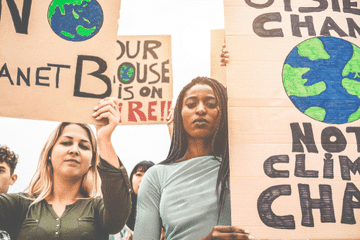
Climate change has been deemed the greatest threat to human health in the 21st century.1 The deleterious effects are impossible to ignore, with both the intensity and duration of extreme weather events rapidly increasing. Meanwhile, COVID-19 has underpinned natural disasters ranging from wildfires and heat waves to flooding and hurricanes, complicating response efforts and impairing population health. Predictably, US communities with higher levels of airborne pollution are at a higher risk for COVID-19–related illness and death.2
COVID-19 is hindering our ability to resist the climate threats we are facing across our communities. But by engaging with environmental health professionals, public health agencies can scale up efforts to address the dual health challenges of our generation. Learn how your health department can work more intentionally alongside local environmental health practitioners to champion climate sustainability from the ground up.
Evaluate the Capacity for Climate Action
Just as COVID-19 has required an all-hands-on-deck approach, promoting climate sustainability involves all members of the public health community. Each division within a public health agency has a role in climate action, and assessing those contributions will make it easier to collaborate with environmental health professionals on ambitious goals.
Work with staff to determine the strengths and areas for growth within their division for addressing climate change and how the expertise of local environmental health professionals could reinforce their efforts. No matter if their specialty is in community outreach or human resources, health department staff can leverage their unique abilities and expertise to combat climate change at the local level.
Lean Into Partnerships
Both health departments and the environmental health workforce are foundational within their communities, making them well suited to forge cross-sector partnerships. Beyond the networks that your health department can access, environmental health professionals may have ties to academic institutions, think tanks, foundations, and other organizations that can bolster climate sustainability efforts. Environmental health professionals may be able to use their connections for assistance with data collection, media outreach, or funding community-based initiatives, as a few examples.
Make a Seat at the Table
The need for environmental health expertise and collaboration continues to grow with emerging threats. Ensure that the door is always open to local practitioners as your organization embraces climate consciousness. This can be as simple as inviting environmental health professionals to staff meetings or introducing them to the experts on your team working on climate-related projects.
Welcoming local environmental health professionals into your agency is critical for building relationships and incorporating their crucial perspectives. Even if a program does not appear to have an environmental health component, allowing outside practitioners into these conversations can prevent unintended consequences for the environmental well-being of your community.
Support Career Pathways in Environmental Health
Investing in the future of the environmental health workforce is essential to promoting climate sustainability. You can support pathways for career advancement for emerging environmental health professionals within your organization, especially those who are underrepresented in the field. This can be accomplished through mentorship, pairing junior staff with seasoned professionals in environmental health.
Another option for career development is membership in organizations such as the National Environmental Health Association and the American Public Health Association’s Environment Section. Or, employees may benefit from participation in leadership opportunities such as ecoAmerica’s Climate for Health Ambassadors Training Program. These avenues for professional development provide the credentials, best practices, and camaraderie needed to succeed in the field.
Connect With Local Grassroots Groups
Getting familiar with local grassroots groups will expose your agency to a diverse component of environmental health, especially among those fighting for justice and equity in this sector. Connecting with these groups can be empowering for staff at public health agencies and even help them reduce feelings of eco-anxiety or hopelessness.
Consider inviting a local group to your organization for a brown-bag lunch discussion with employees to break the ice. Even if staff cannot join meetings or volunteer with a grassroots group, sharing these opportunities via your organization’s social media platforms or Listserv can help spread awareness with minimal effort.
Embrace Environmental Storytelling
Storytelling is a powerful tool for promoting environmental health, making a concept that is often perceived as abstract tangible to people from diverse backgrounds. Telling stories about environmental health and climate action is especially useful when there are anecdotes to demonstrate the impacts of community-based interventions. The environmental health workforce needs these stories showing the value of their efforts to garner community support and awareness.
One such intervention with a clear cause and effect is Green Heart Louisville, an urban greening project involving academia, government, business, and nonprofit groups. Green Heart Louisville shows the benefits of planting trees by comparing air quality and health before and after. The partnership demonstrates that climate change resistance begins locally, fueled by multisector collaboration.
Stories such as these can be used in your health department’s blog content, social media, and marketing materials and may inspire community members to get involved in local environmental health projects.
It is easy to despair when the climate crisis is so overwhelming. Especially for public health agencies at the local level, staff who already feel like they are struggling to keep their heads above water may hesitate to expand their mindset to embrace climate change resistance. But as has been made painfully clear, we do not experience these crises at the intersection of health and environment in isolation, and we cannot be siloed when addressing them. Health departments joining forces with the local environmental health workforce give communities the best chance at success.
References
1. The Lancet Countdown on health and climate change. Lancet. https://www.thelancet.com/countdown-health-climate. Accessed August 6, 2021.




